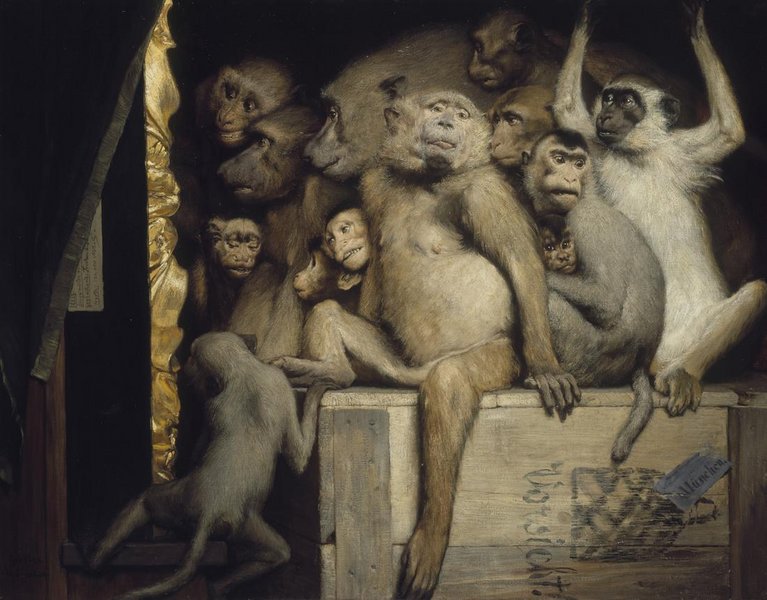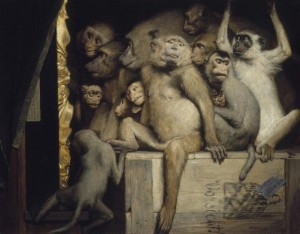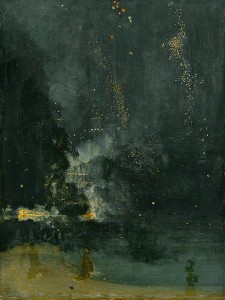ART CRITICISM? Monkeys as Judges of Art.


Monkeys as Judges of Art, 1889, Gabriel von Max
Art criticism is the discussion or evaluation of visual art.
Art critics usually criticize art in the context of aesthetics or the theory of beauty. One of criticism’s goals is the pursuit of a rational basis for art appreciation.
The variety of artistic movements has resulted in a division of art criticism into different disciplines, each using vastly different criteria for their judgements. The most common division in the field of criticism is between historical criticism and evaluation, a form of art history, and contemporary criticism of work by living artists.
Despite perceptions that art criticism is a much lower risk activity than making art, opinions of current art are always liable to drastic corrections with the passage of time. Critics of the past are often ridiculed for either favoring artists now derided (like the academic painters of the late 19th Century) or dismissing artists now venerated (like the early work of the Impressionists). Some art movements themselves were named disparagingly by critics, with the name later adopted as a sort of badge of honor by the artists of the style (e.g. Impressionism, Cubism), the original negative meaning forgotten.

Nocturne in Black and Gold, The Falling Rocket by James McNeill Whistler
John Ruskin famously compared one of James McNeill Whistler’s paintings, Nocturne in Black and Gold: The Falling Rocket, to “flinging a pot of paint in the public’s face”.
Artists have often had an uneasy relationship with their critics. Artists usually need positive opinions from critics for their work to be viewed and purchased; unfortunately for the artists, only later generations may understand it.
History
Origins
Although critiques of art may have its origins in the origins of art itself, art criticism as a genre is credited to have acquired its modern form by the 18th century.
The first writer to acquire an individual reputation as an art critic in 18th C. France was La Font de Saint-Yenne who wrote about the Salon of 1737 and wrote primarily to entertain while including anti-monarchist rhetoric in his prose.
The 18th C. French writer Denis Diderot is usually credited with the invention of the modern medium of art criticism. Diderot’s “The Salon of 1765” was one of the first real attempts to capture art in words. According to art historian Thomas E. Crow, “When Diderot took up art criticism it was on the heels of the first generation of professional writers who made it their business to offer descriptions and judgments of contemporary painting and sculpture. The demand for such commentary was a product of the similarly novel institution of regular, free, public exhibitions of the latest art.” [Published in Diderot on Art I, p.x]
A dominating figure in 19th century art criticism was French poet Charles Baudelaire, whose first published work was his art review Salon of 1845, which attracted immediate attention for its boldness. Many of his critical opinions were novel in their time, including his championing of Delacroix and Courbet. When Manet’s famous Olympia (1865), a portrait of a nude courtesan, provoked a scandal for its blatant realism, Baudelaire worked privately to support his friend.
Pre-World War II
Bloomsbury Group members Roger Fry and Clive Bell were notable English pre-war art critics. Fry introduced post-impressionism to the country, and Bell was one of the founders of theformalist approach to art. Herbert Read championed modern British artists such as Paul Nash, Ben Nicholson, Henry Moore and Barbara Hepworth.
In the U.S, Clement Greenberg first made his name as an art critic with his essay Avant-Garde and Kitsch, first published in the journal Partisan Review in 1939.
Post-World War II
As in the case of Baudelaire in the 19th century, the poet-as-critic phenomenon appears once again in the 20th, when French poet Apollinaire becomes the champion of cubism. Later, French writer and hero of the Resistance André Malraux writes extensively on art, going well beyond the limits of his native Europe. Interestingly, his conviction that the vanguard in Latin America lay in Mexican Muralism (Orozco, Rivera and Siqueiros) changes after his trip to Buenos Aires in 1958. After visiting the studios of several Argentine artists in the company of the young Director of the Museum of Modern Art of Buenos Aires Rafael Squirru, Malraux declares the new vanguard to lie in Argentina’s new artistic movements. Worthy of note is the fact that Squirru, a poet-critic of renown himself who became Cultural Director of the OAS in Washington D.C. during the Sixties, was the last to interview the well-nigh forgotten Edward Hopper before his death, creating a revival which consecrated the American artist once and for all time.
In the 1940s there were not only few galleries (The Art of This Century) but also few critics who were willing to follow the work of the New York Vanguard. There were also a few artists with a literary background, among them Robert Motherwell and Barnett Newman who functioned as critics as well.
As surprising as it may be, while New York and the world were unfamiliar with the New York avant-garde, by the late 1940s most of the artists who have become household names today had their well established patron critics: Clement Greenberg advocated Jackson Pollock and the Color field painters like Clyfford Still, Mark Rothko, Barnett Newman, Adolph Gottlieb andHans Hofmann. Harold Rosenberg seemed to prefer the action painters like Willem de Kooning and Franz Kline. Thomas B. Hess, the managing editor of Art News, championed Willem de Kooning.
The new critics elevated their proteges by casting other artists as “followers” or ignoring those who did not serve their promotional goal.
As an example, in 1958, Mark Tobey “became the first American painter since Whistler (1895) to win top prize at the Biennale of Venice. New York’s two leading art magazines were not interested. Arts mentioned the historic event only in a news column and Art News (Managing editor: Thomas B. Hess) ignored it completely. The New York Times and Life printed feature articles.”
Barnett Newman, a late member of the Uptown Group wrote catalogue forewords and reviews and by the late 1940s became an exhibiting artist at Betty Parsons Gallery. His first solo show was in 1948. Soon after his first exhibition, Barnett Newman remarked in one of the Artists’ Session at Studio 35: “We are in the process of making the world, to a certain extent, in our own image.” Utilizing his writing skills, Newman fought every step of the way to reinforce his newly established image as an artist and to promote his work. An example is his letter in April 9, 1955, “Letter to Sidney Janis: —It is true that Rothko talks the fighter. He fights, however, to submit to the philistine world. My struggle against bourgeois society has involved the total rejection of it.”
Strangely the person thought to have had most to do with the promotion of this style was a New York Trotskyist, Clement Greenberg. As long time art critic for the Partisan Review andThe Nation, he became an early and literate proponent of abstract expressionism. Artist Robert Motherwell, well heeled, joined Greenberg in promoting a style that fit the political climate and the intellectual rebelliousness of the era.
Clement Greenberg proclaimed Abstract Expressionism and Jackson Pollock in particular as the epitome of aesthetic value. It supported Pollock’s work on formalistic grounds as simply the best painting of its day and the culmination of an art tradition going back via Cubism and Cézanne to Monet, in which painting became ever ‘purer’ and more concentrated in what was ‘essential’ to it, the making of marks on a flat surface.
Jackson Pollock’s work has always polarised critics. Harold Rosenberg spoke of the transformation of painting into an existential drama in Pollock’s work, in which “what was to go on the canvas was not a picture but an event”. “The big moment came when it was decided to paint ‘just to paint’. The gesture on the canvas was a gesture of liberation from value–political, aesthetic, moral.”
One of the most vocal critics of Abstract expressionism at the time was New York Times art critic John Canaday. Meyer Shapiro, and Leo Steinberg were also important art historians of the post-war era who voiced support for Abstract expressionism. During the early to mid sixties younger art critics Michael Fried, Rosalind Krauss and Robert Hughes (critic) added considerable insights into the critical dialectic that continues to grow around Abstract expressionism.
Other people, such as British comedian/satirist Craig Brown, have been astonished that decorative ‘wallpaper’, essentially brainless, could gain such a position in art history alongsideGiotto, Titian and Velázquez.
Today
Art critics today work not only in print media-in specialist art magazines as well as newspapers, but also on the internet, on TV and on radio, and in museums and galleries. Many are also employed in Universities or as art educators for museums. Art critics curate exhibitions and are frequently employed to write exhibition catalogues. Art critics have their own organisation, a UNESCO non-governmental organisation, called the International Association of Art Critics which has around 76 national sections and a political non-aligned section for refugees and exiles.
Art Blogs
Since in the early 21st century, online art critical websites and art blogs have cropped up around the world to add their voices to the art world. Some notable blogs include anaba, ArtCal, Art Fag City, Bad at Sports, Art Critical, From the Mayors Doorstep, Bloggy, James Wagner, Fallon and Rosof, CultureGrrl, Winkleman Blog, Two Coats of Paint, Personism, The James Kalm Report, Beauty Flow Magazine, Sharkforum blog, Wooster Collective blog, and Brian Sherwin’s Myartspace Blog.
References
- Levin on Hopper, “An intimate biography”
- Thomas B. Hess, “Willem de Kooning”, George Braziller, Inc. New York, 1959 p.:13
- William C. Seitz, Mark Tobey by William C. Seitz, The Museum of Modern Art, New York, 1962.
- Barnett Newman Selected Writings and Interviews, (ed.) by John P. O’Neill, pgs.: 240-241, University of California Press, 1990
- Barnett Newman Selected Writings Interviews, (ed.) by John P. O’Neill, p.: 201, University of California Press, 1990.
- Clement Greenberg, Art and Culture Critical essays, (“The Crisis of the Easel Picture”), Beacon Press, 1961 pp.:154-157
- Harold Rosenberg, The Tradition of the New, Chapter 2, “The American Action Painter”, pp.:23-39
Source: en.wikipedia.org


This Post Has 2 Comments